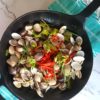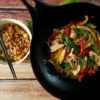We grew up eating these, and they come in all shapes and sizes. In Singapore, we eat the tiny ones (Youmian), fat and thick ones (Hokkien mee), flat ones (mee pok). Often mistaken as an egg noodle, these are different. They are vegan instead, since they are made of only water, alkaline water (kansui) and flour. Often, people use bread flour, I found that plain flour work just as well, and decided the recipe should just be with plain flour.
These noodles are super QQ, this QQ thing is a Chinese description of a texture and mouth feel that cannot be described in English. It is bouncy, yet the dough gives. When we make certain kinds of pastry and kueh, or even fish balls and dumplings, we often want this mouth feel.
The reason for using alkaline water is to change the gluten structure of the noodles, and hence create this QQ mouth feel. The trick to make home made noodles QQ is to incorporate as little water as possible into the dough, making it a super hard dough to knead. A good machine is in order here, or a lot of muscles.
You only need to knead the noodles for 5 minutes, let it rest and then shape the noodles. (Yes! Very much like bread!)
I didn’t rest the dough, as I have boys’ muscles in my children at home, and therefore our noodles are ready in 15 minutes.
Trust me, once you’ve tried these, you won’t buy noodles ever again. They are easy to make, delicious, don’t go soggy and absorb whatever wonderful ingredients you have prepared!
Alkaline Noodles (Ramen, Chinese noodles)
Ingredients
- Equipment: pasta maker or a fancy one
- 4 cups of plain flour or bread flour
- 1 cup of water at room temperature
- 2 Tbsp alkaline water kan sui
- Handful of corn flour for dusting only
Instructions
- Put everything except the corn flour into a mixer and mix for 5 minutes. You can use a bread maker.
- The result is tiny rounds of dry dough. Gather them into a ball.
- Cut the ball into about 8cm x 3 cm x 1 cm thick. Dust with generous amount of corn flour. I used a pasta making machine and worked through from the thickest setting down to #5 or spaghetti setting or any setting you like, one at a time. I use #5 ramen or soba, and #6 youmian and mee pok.
- Dust with corn flour again to ensure they don't stick.
- Cook the way you want, I use lots of water and bring that to a boil. Add the noodles and let the noodles cook freely (not constrained to a net), and when the water boils again, I dish the noodles out from the hot water, dunk the noodles into ice cold water to improve the texture.
- That's it!

This is what it looks like out of the mixer or kneading machine

Bring the crumbs altogether using your hand.

Cut into noodles using a pasta machine.







